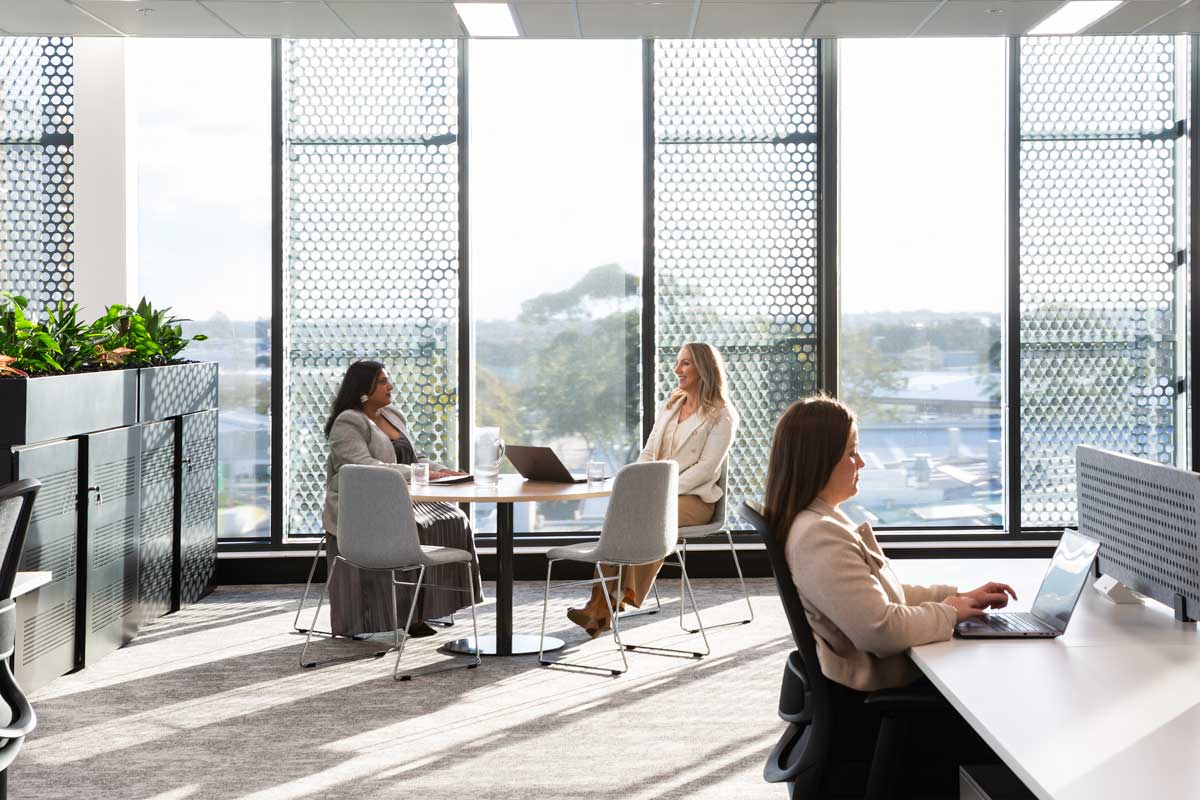Optimizing Office Space: Understanding Recommended Area per Person
Effective office space planning is essential to ensure that your workspace aligns with both current operations and future growth. According to the Building Code of Australia, the recommended office space per person is 10 square meters. However, many organizations opt for 12–14 square meters to enhance comfort and productivity. For businesses requiring additional privacy, such as legal or consulting firms, the office area per person may increase to 14–18 square meters. These figures exclude communal areas like kitchens and corridors, emphasizing the need for comprehensive planning. By assessing your specific needs and anticipating future changes, you can determine how much office space you need to design a workspace that is both efficient and adaptable.
Office space size is a primary consideration when you’re relocating, renewing a commercial lease or having employees return to the workplace. The right office area not only helps your employees stay productive and efficient but can support the growth of your business in the future.
If you’re not sure how much office space you really need, here’s what we typically factor in when we’re developing a customised workplace strategy for our clients.
Your organisational strategy
What type of organisation are you? Your physical and hybrid work environment reflects your brand, intentionally or unintentionally.
The first step to calculating the space you really need is determining how your employees or customers will use the environment. What type of tasks do your employees perform and how often do they spend time at their desks each day? How much storage space do they need – physical or digital?
Is your culture fostered aroundworking collaboratively with each other where defined spaces encourage interaction, inspiration & innovation? How much storage space is required - physical or digital? You also need to consider how many meetings take place in your company, how large the meetings are and potential technologies to maximise collaborative efficiency.
Read more: How technology trends are impacting workplace design
Your business objectives
Before you get bogged down in details, it’s important to consider your overall business objectives and the purpose of your workplace relocation or redesign.
Are you hoping to improve staff productivity? Reduce building management costs? Enhance collaboration between teams? Focus the office experience towards a healthier, supportive and sustainable environment? Use your office more efficiently?
Understanding what you’re looking to achieve will help you determine how much floorspace you’ll need to achieve it.
Your spatial requirements
The Building Code of Australia requires a minimum of 10m2 per person for office workers, but many companies prefer to estimate their spatial requirements at a comfortable 12 to 14m2. Organisations that require more enclosed office spaces for client or acoustic privacy, such as law, psychology or accounting firms, may need to calculate their requirements at 14 to 18m2 per employee.
These figures are based on approximate net lettable area's and don’t include common building core zones such as kitchens, bathrooms, shared corridors, or lift lobby areas. They’re just estimations, so it’s best to talk to a workplace designer to get an accurate estimate before renting or buying new office space.
Read more: Top tips for budgeting an office move
Your future needs
As well as thinking about your current needs, it’s essential to consider the future needs of your business.
The only constant we can count on is change. Many commercial leases run for three years or more – which is an age in today’s fast paced world.
You’ll need to ensure capacity for additional employees if you’re thinking of expansion or operational consolidation. You should also consider how much office space you’ll need if you downsize, automate workflows, divest or outsource business functions, merge with another company or undergo a restructure where teams will grow or change in size.
The amount of space you need for technology is also likely to change in the future, particularly if you’re planning to move your IT infrastructure into the cloud or relocate your data centre operations offsite. By considering how your business will look in three, five or even 10 years’ time, you’re in a better position to choose a workplace flexible enough to grow and change as your business does. How can you create a workplace flexible enough to accommodate the future?
Office Space Standards and Guidelines in Australia
When planning a new office layout, lease, or workplace redesign, it’s essential to understand the current office space standards and guidelines in Australia. These standards ensure your workspace is both compliant and practical for the needs of your team.
According to the Building Code of Australia, the minimum office space per person is 10 square metres. However, this baseline doesn’t always suit modern work environments. Many companies choose to allocate 12 to 14 square metres per employee to create a more comfortable and productive environment.
Understanding Australian Standards for Office Layouts
The Australian standard office space per person can vary depending on the nature of your business and the roles of your employees. For example, legal and consulting firms often require additional room to ensure confidentiality and acoustic privacy. In these industries, the legal office space per person may range from 14 to 18 square metres. These estimates are focused on usable space and do not include communal areas such as hallways, kitchens, or bathrooms.
When calculating your office needs, consider more than just desk space. Think about how your team collaborates, how often they’re in the office, and how your layout supports storage, technology, and flexibility. The space required per person in an office should reflect your working style and future planning goals.
How Much Office Space Per Person Do You Really Need?
Many businesses ask, “How much office space per person is needed?” or “What is the ideal office space per employee?” The answer depends on your business model, number of staff, and how often they work on-site. The typical office space per employee in Australia is between 12 and 14 square metres, though this can increase for organisations with complex workflows or specialised equipment.
The minimum office size for 1 person, as legally required, remains at 10 square metres. However, companies aiming for staff wellbeing and operational efficiency usually choose more. These considerations apply equally to large teams and small businesses working in compact office spaces.
Matching Office Space with Storage and Density
It’s also important to consider office layout efficiency. Office density or how many people are placed within a given floor area has a direct impact on comfort and performance. A balanced layout with the right mix of office space and storage ensures your team isn’t cramped, while also avoiding unnecessary overhead costs.
As your team grows or your work culture shifts (for example, from fully in-person to hybrid), your office workspace must also evolve. Effective office space planning standards include storage zones, collaborative spaces, quiet areas, and flexibility for future adjustments. The goal is to support productivity while remaining adaptable.
Estimating Costs and Value Per Employee
Business leaders also consider the average cost of office space per employee when budgeting for new premises. Calculating this cost is not just about rent per square metre it also involves planning for functionality, technology, and long-term use.
When planning for the office space required per person, a careful balance between cost and practicality helps avoid both underutilisation and overcrowding. With expert advice, you can achieve a layout that reflects your brand, supports your staff, and scales with your growth.
Final Thoughts: Define the Best Office Space for Your Needs
Whether you're managing a redesign, an expansion, or a downsizing plan, understanding your office space requirements is the key to making informed decisions. At Axiom Workplaces, we use these office space standards per person to guide our clients in creating functional, future-ready workplaces that are aligned with both regulatory needs and commercial goals.
From calculating office size per person to exploring options for workstation office space standards, we help you define what success looks like for your business environment. Reach out to our team to discover how we can help you plan your next move with confidence.
Conclusion
Choosing the right amount of office space isn’t just about following rules, it's about creating a workspace that fits your team’s daily needs and long-term goals. From understanding minimum office size requirements to planning for future growth, getting the balance right helps your business run smoothly and keeps your employees comfortable and productive.
By using Australian guidelines and practical planning strategies, you can make confident decisions about how much space you really need. Whether you're moving into a new office, renewing a lease, or rethinking your layout, it's important to think ahead and design a workspace that works for everyone.
Why Choose Axiom Workplaces?
At Axiom Workplaces, we take the guesswork out of office planning. Our team understands the importance of creating work environments that are functional, flexible, and aligned with your business goals.
We don’t just follow space standards, we look at your whole workplace strategy, including your culture, team structure, technology, and long-term vision. Whether you need help with workplace design, office relocation, or calculating the right square metres per person, we’re here to guide you every step of the way.
Let’s create a workplace that supports your people and grows with your business.
Need help planning your office space layout?
Get in touch with Axiom Workplaces to design a workplace that fits your people, purpose, and future growth.
Frequently Asked Questions
Need expert advice in developing a workplace strategy and design to make the right decision on the size of your next office move?
Read about how workplace design influences to enhance wellness and wellbeing in the workplace below or contact us and discover how we can help.






